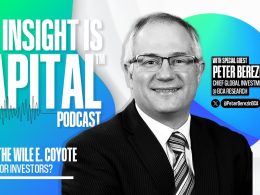Christmas
by Jeffrey Saut, Chief Investment Strategist, Raymond James
December 9, 2013
Well it is official, Christmas has begun. For me it began with the private wine and dinner party at Morrell, arguably the finest wine store I have ever seen, and anyone that knows me knows I have seen a lot of wine stores! Morrell is located at 1 Rockefeller Center between 5th Avenue and 6th Avenue overlooking the Christmas tree at Rockefeller Center. I had done a gig on Bloomberg radio at Morrell last Tuesday with my friends Carol Massar and Pimm Fox and got invited to the party the next evening to watch the lighting of the Christmas tree. Many notables were there to watch the tree lighting and drink wine. We also ate some marvelous food from the wine bar/restaurant next door; both locations are owned by the gracious Roberta Morrell. The next night I attended a gathering of the Friends of Fermentation (FoF), at Bobby Van’s next to the NYSE, to celebrate the repeal of prohibition. Art Cashin and Bob Pisani were two of the charter members of FoF and as the wine flowed, so did the stories. The next night Cheryl and I rode the LIRR up to Port Washington to attend another festive party thrown by Minyanville’s founder, and my friend, Todd Harrison, and his dazzling wife Jamie. Hereto, there were many Wall Street notables there, like Yahoo’s (YHOO/$38.86/Outperform) Michael Santoli. Obviously this trifecta made me feel like a true New York City insider. The final Christmas arrival event was watching the annual presentation of the Wizard of Oz over the weekend. Most people know The Wizard of Oz as one of the most popular films ever made. What is little known, however, is that the book is based on an economic and political commentary surrounding the debate over “sound money” that occurred in the late 1800s.
Indeed, L. Frank Baum’s book was penned in 1900 following unrest in the agriculture arena (read: farmers) due to the debate over gold, silver, and the dollar standard. The book, therefore, is supposedly an allegory of these historical events making the information easier to understand. In said book, Dorothy represents traditional American values. The Scarecrow portrays the American farmer, while the Tin Man represents the workers and the Cowardly Lion depicts William Jennings Bryan. Recall that at the time, Mr. Bryan was the official standard bearer for the “silver movement,” as well as the unsuccessful Democratic presidential candidate of 1896. Interestingly, in the original story Dorothy’s slippers were made of silver, not ruby, implying that silver was the Populists’ solution to the nation’s economic woes. Meanwhile, the Yellow Brick Road was the gold standard and Toto (Dorothy’s faithful dog) represented the Prohibitionists, who were an important part of the silverite coalition. The Wicked Witch of the West symbolizes President William McKinley and the Wizard is Mark Hanna, who was the chairman of the Republican Party and made promises that he could not keep. Obviously “Oz” is an abbreviation for “ounce.” It should be noted that before 1873 the U.S. dollar was defined as consisting of either 22.5 grains of gold or 371 grains of silver. This set the legal price of silver in terms of gold at roughly 16:1 and put the country on a gold/silver bimetallic standard. Since both metals had other uses than just coinage, whenever the ratio got out of whack, rational people would buy the cheaper metal and take it to the mint to coin. That provided a natural stabilizing arbitrage. With the 1873 Coinage Act, however, the silver dollar was omitted, effectively shifting the country from a bimetallic to a gold standard. Other countries soon followed this shift and as tons of silver were unloaded, the market price of silver in terms of gold rose from 16:1 to 40:1. The result was that the dollar was now linked to a metal that was getting scarcer and scarcer.
Particularly hurt by these events were the net debtors, among them the farmers because they had to face a rising real value of their debts combined with declining agricultural prices (in dollar terms). Now, while there was a bunch of “noise” in between (the Sherman Silver Purchase Act of 1890, the panic and depression of 1893, etc.), the situation hit its zenith in 1896 culminating with William Jennings Bryan’s “Cross of Gold” speech at the Democratic National Convention.
While I have digressed, I truly find monetary history fascinating and would note that the value of our dollar, valued in 1900 dollars, is currently worth roughly $0.02. That is why you want to have your dollars invested in assets that throw off cash flows, hopefully pay dividends, and can keep up with the inflation that is certain to follow. Indeed, you cannot find any instance in history where an economy has had this much cash thrown into it and not had inflation come out the other side. My asset class of choice remains equities. To that point, I spent a lot of time with various portfolio managers (PMs) while in Manhattan last week. On Monday I spent a few hours at Goldman Sachs with a number of PMs. The two I was most interested in were Ron Arons, who along with Michael Swell manages the Goldman Sachs Strategic Income Fund (GSZAX/$10.58), and Alexis Deladerrière, who manages the Goldman Sachs Concentrated International Equity Fund (GSIFX/$19.87). Ron believes that interest rates are headed higher and at this time next year expects the yield on the 10-year T’note to be between 3.5% and 4.0%. He also thinks the high yield complex’s aggregate yield may decline by another 50 to 100 basis points, but the “easy money” has been made. Alexis has captained GSIFX to its top decile performance. Like me, he is negative on emerging markets and thinks Europe is a mixed picture that will take years to fully recover. He did say that the European Central Bank’s emergence next year as the “sole regulator” is a good thing longer term because, while it will be very tough on banks initially, after that it should be a pretty good ride. Alexis ended by noting China finally has strong leadership, which is a good thing implying China is not going to implode. The rest of Monday was spent doing CNBC, Arise TV, The Wall Street Journal, and the Financial Times.
Tuesday I spent time seeing hedge funds, having lunch with my friend Mary Lisanti, whose fund AH SmallCap Growth Fund (ASCGX/$19.73) I own, and as stated doing Bloomberg radio and TV. Dinner was with friends. Wednesday began with more hedge fund meetings, but lunch was with Rich Bernstein, eponymous captain of Richard Bernstein Advisors. Rich manages two funds for Eaton Vance (EARAX/$12.35 and ERBAX/$13.88), as well as an ETF for First Trust (FWRVLX/$10.28), all of which play to the American Industrial Renaissance theme. Readers of these comments know I have embraced that theme for more than three years. For individual stock ideas I suggest looking at the top holdings of these funds, or better yet buy the funds. Wednesday afternoon I saw more accounts and then I went to the tree lighting party.
Thursday started with a working breakfast and then a quick trip to Jersey City to converse with portfolio managers at Lord Abbett. My friend Chris Towel was first on the agenda; he oversees the Lord Abbett Bond Debenture Fund (LBNDX/$8.27). Like Goldman’s Ron Aron, Chris thinks rates are going up, but he has managed to avoid the downside fate of most other bond funds this year by using Lord Abbett’s excellent fundamental research. Speaking of excellent research, Tom O’Halloran stopped by to discuss stocks he owns in the Lord Abbett Growth Leaders Fund (LGLAX/$20.55), which I own. In addition to his Six Rivers of Growth themes (talked about that on our recent joint conference call), Tom waxed about individual ideas he owns in his fund like Intercontinental Exchange Group (ICE/$218.20/Outperform) and Facebook (FB/$47.94/Outperform). Additionally, he spoke about “cloud computing” being an accelerant for capitalism, ecommerce, and social networking; plainly I agree.
On Friday I spent the morning with the good folks at JP Morgan (JPM/$56.06/Strong Buy). Unbelievably, I had to turn down a spontaneous meeting with CEO Jamie Dimon because I had agreed to see another hedge fund that afternoon, but I did meet with George Gatch and Tom Ludy, the icons of JP Morgan Asset Management. Tom is a huge free “cash flow” advocate, which certainly foots with me since I was taught that money is the “blood” of a company and the cash flow statement is the “veins!” He suggested forgetting about the stock market’s short-term “wiggles” and to focus on the primary trend! He thinks the Fed will achieve its economic growth objective and that the next upside “leg” for the equity markets will be based on a return of confidence. I would like to discuss the other PMs I spoke with at JPM, but I have run out of space. I will be doing so in the missives yet to come.
The call for this week: Most of last week’s action suggested the anticipated decline to set-up the Santa rally had begun. However, Friday’s news-induced rally called that into question. Still, Friday’s Fling showed not much evidence that Sellers have become exhausted and the “sell signals” of November 19th and December 2nd remain in place. This week should tell the short-term tale of the equity markets.















